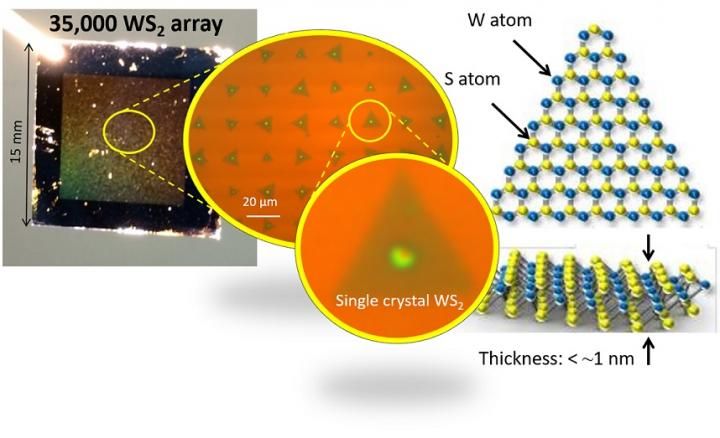Clarification of a new synthesis mechanism of semiconductor atomic sheet
Toward the realization of next-generation flexible optoelectronic devices
Advertisement
In Japan Science and Technology Agency's Strategic Basic Research Programs, Associate Professor Toshiaki Kato and Professor Toshiro Kaneko of the Department of Electronic Engineering, Graduate School of Engineering, Tohoku University succeeded in clarifying a new synthesis mechanism regarding transition metal dichalcogenides (TMD), which are semiconductor atomic sheets having thickness in atomic order.

A substrate (left photograph) that is fabricated by integrating about 35,000 monolayer single crystals of WS2, and a structural schematic of the monolayer single crystal of WS2 (right figure).
©Toshiaki Kato
Because it is difficult to directly observe the aspect of the growing process of TMD in a special environment, the initial growth process remained unclear, and it has been desirable to elucidate a detailed mechanism of synthesis to obtain high-quality TMD.
An in-situ observing synthesis method has been developed by our research group to examine the growth aspect of TMD as a real-time optical image in a special high temperature atmosphere of about 800°C in the presence of corrosive gases. In addition, a synthesis substrate, which is a mechanism to control diffusion during the crystal growth of a precursor, has been developed in advance; further, it has been clarified that the growing precursor diffuses a distance about 100 times larger than in conventional semiconductor materials. It was also demonstrated that nucleation occurs due to the involvement of the precursor in a droplet state. Furthermore, by utilizing this method, a large-scale integration of more than 35,000 monolayer single crystal atomic sheets has been achieved on a substrate in a practical scale.
Utilizing the results of the present research, the large-scale integration of atomic-order thick semiconductor atomic sheets can be fabricated and is expected to be put into practical use in the field of next-generation flexible electronics.
Original publication
Other news from the department science
Most read news
More news from our other portals
See the theme worlds for related content
Topic world Synthesis
Chemical synthesis is at the heart of modern chemistry and enables the targeted production of molecules with specific properties. By combining starting materials in defined reaction conditions, chemists can create a wide range of compounds, from simple molecules to complex active ingredients.

Topic world Synthesis
Chemical synthesis is at the heart of modern chemistry and enables the targeted production of molecules with specific properties. By combining starting materials in defined reaction conditions, chemists can create a wide range of compounds, from simple molecules to complex active ingredients.

































































